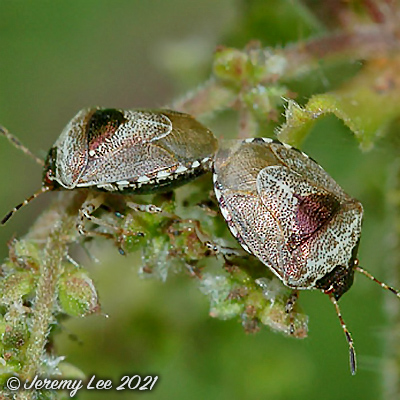
 |
|
Scientific Classifications explained » Amphibians » Ants » Aphids » Bees » Beetles » Birds » Bugs » Butterflies » Caterpillars » Damselflies » Dragonflies » Earwigs » Flies » Frog/Leafhoppers » Fungi » Galls » Grasshoppers » Harvestmen » Hoverflies » Lacewings » Ladybirds » Leaf Mines » Lichens » Mammals » Millipedes » Mosses » Moths » Sawflies » Slugs » Snails » Spiders » Trees & Shrubs » Wasps » Wild Flowers » Woodlice » Postboxes |
UK Nature > Bugs > Eysarcoris venustissimus

Common Name: Woundwort Bug Scientific Name: Eysarcoris venustissimus With a length of approximately 5mm, Eysarcoris venustissimus, more commonly known as the Woundwort Bug, is generally found in the southern half of England and Wales. They are quite small, but can sometimes be spotted glistening on nettles and woundwort plants on sunny days. Their bodies are a greyish-white colour and have patches of metallic bronze on the head, the front of the pronotum, and on the front of the scutellum, while the connexivum is marked with black and white. The larvae, which appear late June until October, colony feed on the seeds of Hedge Woundwort (Stachys sylvatica) and sometimes other plants in the Labiateae such as white dead-nettle. Although rare in the 19th century, this shieldbug is now widespread in southern and central Britain as far north as Yorkshire, in hedgerows and woodland edges. |
|

https://www.uknature.co.uk is a website dedicated to showing the immense diversity of UK nature and wildlife. Our vast range of habitats, from lowland arable to snow covered mountains, from storm-ravaged coastlines to peaceful inland freshwater lakes and rivers, from dry, sandy heaths to deciduous and coniferous forests, all these habitats contribute to the abundance of UK nature. We have wild birds in huge numbers either residing or visiting our shores (597 recorded species as at July 2013) and we must also not forget the humble back garden with its grass lawns, flower beds filled with nectar rich flowers, shrubs and trees, all designed to attract huge numbers of insects such as bees, moths, butterflies and hoverflies; and finally the small ponds which provide safe havens for frogs, toads, newts and even slow worms and grass snakes. www.uknature.co.uk is the showcase for my personal passion, photographing uknature in all its glory. I sincerely hope you all enjoy the fruits of my labours. This site and all images contained therein is © Jeremy Lee 2004 - 2025. All Rights Reserved. Site design by Jeremy Lee. Site development & IT Support by Stuart Lee. |